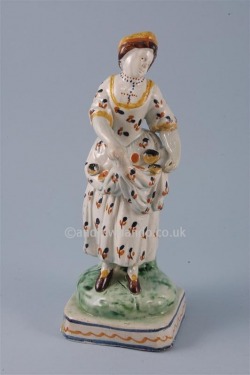This sweet figure is no ordinary lass. Instead, she portrays someone well-known to the refined early 19th century home-owners who bought her. Her name is Iphigenia. Iphigenia was a character from the operetta Decameron. The figure was made by the Wood family from the late 1700s in both colored glazes and enamels, numbered 96 or 98 of 136.

Iphigenia. Decorated in enamel colours. H: 7 1/2".
From the stock of Andrew Dando.

Iphigenia. Decorated in underglaze colors. H: 9".
From the stock of Andrew Dando.
In its first form, The Decameron is a novella written c1350 by the Italian Giovanni Boccaccio. It is set in Cyprus. Cymon, deemed a dolt by his aristocratic father, is sent to live and work among his slaves in the countryside and he becomes increasingly coarse. One day, he finds highborn Iphigenia, slumbering in a field. Cymon has never seen a woman before and he is so smitten by Iphigenia's beauty that his noble bearing surfaces and his father restores his rightful position in the family. But alas--and of course!--Iphigenia is promised to another, yet this tale of wars and abduction in the name of love ends happily with Cymon and Iphigenia united for life. In 1700, John Dryden published his Fables, Ancient and Modern, containing the story as a poem.
So from all this come Staffordshire's glorious Iphigenia--not a particularly common figure. And she reminds us that every figure has a tale to tell!






























